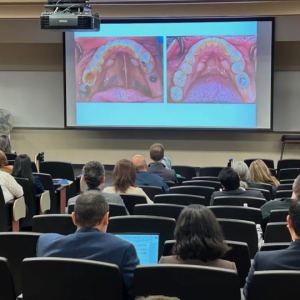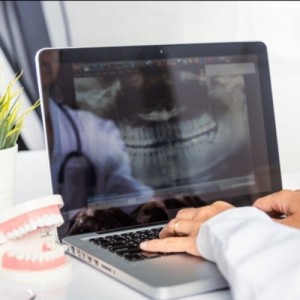
Monolithic multilayer zirconia fixed partial dentures (FPDs): conventional vs digital impression fabrication
Co-authors: A. Comba, F. Del Bianco
Lorenzo Breschi
Monolithic translucent and multilayer zirconia fixed partial dentures are relatively new treatment that gained popularity thanks to the evolution of dental digital workflows.
Morsy et al. noticed that the modified microstructure of these material improved aesthetic outcomes, however the effect of such modifications on the fit of the restoration and the clinical success still need to be investigated. In addition, the authors pointed out that also the impression could influence the results of a precise fixed partial denture.
For these reasons they conducted a study to compare the accuracy of conventional and digital impressions based on the fit of produced threeunit fixed partial dentures (FPDs) in vivo and the trueness and precision of both impression techniques.
Material & Methods
Morsy et. al, from the University of Alexandria, Egypt, selected twelve patients that received both a conventional polyether impression (group C, control, n=12) and a digital impression with CS3500 (group D, test, n=12). Monolithic multilayer zirconia FPDs were fabricated, and the internal and marginal fit were assessed by the authors using the replica technique, trueness and precision of both impression methods were assessed in vitro. In order to create a reference the authors created a master model. Furthermore, the master model received conventional impressions (group C, control, n=5) and digital impressions (group D, test, n=5) by the researchers. The virtual models of both groups were superimposed over the reference scan (5 superimpositions) using a three-dimensional (3D) processing software, and the 3D deviations were measured and averaged to obtain trueness value. For precision, the virtual models of each group were superimposed over each other (10 superimpositions) and the average deviation value was calculated. The data were analyzed by the authors using one-tailed Mann–Whitney U test at P ≤ 0.05.
Results
The researchers from Egypt noticed that Group D resulted in a significantly better marginal and internal fit (30.91±15.15 and 30.86±13.57 μm for group D and 40.02±19.50 and 41.86±18.94 μm for group C). Furthermore the mean values of trueness and precision for conventional and digital techniques noticed by the authors were comparable (trueness: 62.8±5.45 and 62.72±12.01 μm and precision: 56.47±27 and 60.9±14.5 μm, respectively).
Conclusions
Morsy et al. concluded that no significant difference was found between conventional and digital impressions in 3D datasets accuracy. In addition, both techniques resulted in FPDs with an acceptable clinical fit. However, the authors noticed that FPDs fabricated using the digital technique displayed better internal and marginal fit.
For more information: Fit of monolithic multilayer zirconia fixed partial dentures fabricated by conventional versus digital impression: a clinical and laboratory investigations.
 Related articles
Related articles
Editorials 02 October 2025
U-M School of Dentistry hosts national symposium on digital dentistry education
The University of Michigan School of Dentistry hosted a national Digital Dentistry Educators Symposium last week that drew faculty and leaders from 35 dental schools around the country.
Digital Dentistry 29 August 2025
Digital dentistry: The new state of the art — Is it disruptive or destructive?
Summarizing the new state of the art of digital dentistry, opens exploration of the type and extent of innovations and technological advances that have impacted – and improved – dentistry.
Endodontics 15 August 2025
Feasibility of Implementing Digital Dentistry Section in Dental Clinic of a Military Centre
Digital dentistry is not the wave of the future, it is happening now. Whether a dentist embraces the new technology determines the quality of treatment and possibly his future; for this reason,...
Digital Dentistry 23 July 2025
Contemporary Digital Dentistry for Complex Cases in the Anterior Maxilla
To demonstrate how contemporary digitally driven workflow can enhance outcomes for complex esthetic dental cases, focusing on three distinct clinical scenarios involving implant placement, esthetic...
 Read more
Read more
Editorials 10 October 2025
With proud smiles and crisp white coats, ninety-three learners from the DDS Class of 2029 and the International Dentist Pathway Class of 2028 marked the start of their dental careers at the UCSF...
Periodontology 10 October 2025
Continuous professional development (CPD) in Periodontology refers to the overall framework of opportunities that facilitate a life-long learning practice, driven by the learner-practitioner and...
TheraBreath, the #1 alcohol-free mouthwash brand in the U.S.*, has introduced a new line of dentist-formulated, clinically tested toothpastes designed to support professional oral care...
News 10 October 2025
New officers and trustees were installed at the Minnesota Dental Association’s Leadership Conference on September 19 in Minneapolis.
News 10 October 2025
Smartee Denti-Technology today announced that Professor Gang Shen, its Chief Scientist and Executive President of TaiKang ByBo Dental, has once again been named to the World’s Top 2% Scientists...















